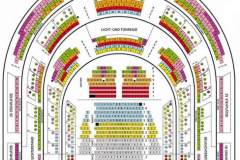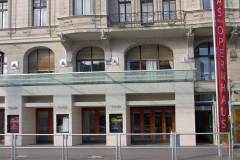La morte d’Orfeo
January 2026 | ||||||
|---|---|---|---|---|---|---|
Mo | Tu | We | Th | Fr | Sa | Su |
Concert performance in Italian with German surtitles
Introduction to the work 30 minutes before curtain-up
TRAGICOMEDIA PASTORALE IN FIVE ACTS
LIBRETTO AFTER ANGELO POLIZIANO
Where Claudio Monteverdi’s L’Orfeo ends is where Stefano Landi’s La morte d’Orfeo starts: the gifted singer Orpheus has tried without success to rescue his wife Eurydice from the underworld. Now he renounces all worldly pleasures to dedicate his life to despair. This alerts the god of wine who, without further ado, has Orpheus killed. But this signals the start of another drama, at least for the gods and muses: Should the dead hero ascend to Olympus in glory or be reunited with Eurydice in Hades? While the musical language of Stefano Landi’s La morte d’Orfeo, first performed in Rome in 1619, is clearly influenced by Monteverdi in that it also incorporates artful madrigal choruses, it also fascinates through Landi’s own idea of thrilling musical theatre: here, tragedy and comedy are given absolutely equal importance.
Synopsis
After Orpheus has failed to save his wife Eurydice from the underworld, he renounces wine and the love of women. This offends the god Bacchus who urges his female followers, the Maenads, to kill Orpheus. The enraged Maenads tear him apart. The gods want the dead Orpheus to join them on Olympus but Orpheus wants to be reunited with Eurydice in Hades. Only after the god Mercury shows him that, having drunk the waters of Lethe, Eurydice no longer remembers her husband, does Orpheus agree to ascend to Olympus.
Program and cast
Conductor: Stéphane Fuget
Orfeo: Juan Sancho
Mercurio / Bacco: Paul Figuier
Terzo Euretto /Calliope: Eva Zaïcik
Aurora / Lincastro: Anaïs Yvoz
Secondo Euretto / Fosforo: Floriane Hasler
Primo Euretto / Euridice: Hasnaa Bennani
Teti / Nisa: Claire Lefilliâtre
Fato / Fileno: Vlad Crosman
Furore /Caronte: Alessandro Ravasio
Ebro / Giove: Alexandre Adra
Ireno / Apolline: Marco Angioloni
Les Épopées
Theater an der Wien
About the Theater an der Wien
The New Opera House is not just any theatre, but the one that Emanuel Schikaneder, the all-round genius, actor, impresario with a flair for organization but above all librettist of The Magic Flute, had built in 1801 in Vienna in keeping with the spirit of Mozart.
To coincide with the 250th anniversary of Mozart’s birth the Theater an der Wien presents itself as a new opera house from January 2006. As a “season” opera house with productions all the year round the Theater an der Wien carves a new and independent niche in the realm of high-quality culture in Vienna. For twelve months of the year, with one premiere every month, opera will be performed under the “stagione”, or season, system: that means the cast remains unchanged from the first performance to the last one, which guarantees that the very highest international standards are maintained.
The theatre’s modern, accessible approach to music theatre as demonstrated by the works performed, the overall artistic concept Bespielung and the artistes is further underlined by the building itself, its architecture and the vibrancy of its location. The surroundings and materials, the intimate atmosphere and perfect acoustics in the historical theatre prepare the senses to experience beauty. The Theater an der Wien deliberately enters into a symbiotic relationship with its lively surroundings on the Naschmarkt street market and the young cultural scene centred in the Schleifmühl quarter.
How to get there
With public transport:
We can be reached by public transport:
U1, U2 und U4 Station Karlsplatz, Exit Secession
Bus 59A Station Bärenmühldurchgang
Bus 57A Station Laimgrubengasse, pedestrians via Laimgrubengasse to Linke Wienzeile
KAMMEROPER:
Fleischmarkt 24, 1010 Wien
We can be reached by public transport:
U1, U4: Station Schwedenplatz
Tram Linie D (bei Ablenukung über Kai), 1, 2: Station Schwedenplatz
Bus 3A (on workdays)

 EN
EN DE
DE IT
IT FR
FR ES
ES RU
RU JP
JP RO
RO
 Seating plan
Seating plan 